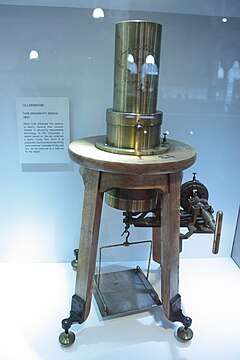
Back Piëso-elektrisiteit Afrikaans كهرباء انضغاطية Arabic П’езаэлектрычны эфект Byelorussian Пиезоелектричен ефект Bulgarian Piezoelektricitet BS Piezoelectricitat Catalan ماددەی پیێزۆ کارەبایی CKB Piezoelektrický jev Czech Piezoelektrisk effekt Danish Piezoelektrizität German

Piezoelectricity (/ˌpiːzoʊ-, ˌpiːtsoʊ-, paɪˌiːzoʊ-/, US: /piˌeɪzoʊ-, piˌeɪtsoʊ-/)[1] is the electric charge that accumulates in certain solid materials—such as crystals, certain ceramics, and biological matter such as bone, DNA, and various proteins—in response to applied mechanical stress.[2] The word piezoelectricity means electricity resulting from pressure and latent heat. It is derived from Ancient Greek πιέζω (piézō) 'to squeeze or press', and ἤλεκτρον (ḗlektron) 'amber' (an ancient source of static electricity).[3][4] The German form of the word (Piezoelektricität) was coined in 1881 by the German physicist Wilhelm Gottlieb Hankel; the English word was coined in 1883.[5][6]
The piezoelectric effect results from the linear electromechanical interaction between the mechanical and electrical states in crystalline materials with no inversion symmetry.[7] The piezoelectric effect is a reversible process: materials exhibiting the piezoelectric effect also exhibit the reverse piezoelectric effect, the internal generation of a mechanical strain resulting from an applied electric field. For example, lead zirconate titanate crystals will generate measurable piezoelectricity when their static structure is deformed by about 0.1% of the original dimension. Conversely, those same crystals will change about 0.1% of their static dimension when an external electric field is applied. The inverse piezoelectric effect is used in the production of ultrasound waves.[8]
French physicists Jacques and Pierre Curie discovered piezoelectricity in 1880.[9] The piezoelectric effect has been exploited in many useful applications, including the production and detection of sound, piezoelectric inkjet printing, generation of high voltage electricity, as a clock generator in electronic devices, in microbalances, to drive an ultrasonic nozzle, and in ultrafine focusing of optical assemblies. It forms the basis for scanning probe microscopes that resolve images at the scale of atoms. It is used in the pickups of some electronically amplified guitars and as triggers in most modern electronic drums.[10][11] The piezoelectric effect also finds everyday uses, such as generating sparks to ignite gas cooking and heating devices, torches, and cigarette lighters.
- ^ Wells, John C. (2008). Longman Pronunciation Dictionary (3rd ed.). Longman. ISBN 978-1-4058-8118-0.
- ^ Holler, F. James; Skoog, Douglas A. & Crouch, Stanley R. (2007). Principles of Instrumental Analysis (6th ed.). Cengage Learning. p. 9. ISBN 978-0-495-01201-6.
- ^ Harper, Douglas. "piezoelectric". Online Etymology Dictionary.
- ^ πιέζειν, ἤλεκτρον. Liddell, Henry George; Scott, Robert; A Greek–English Lexicon at the Perseus Project.
- ^ Harper, Douglas. "piezoelectric". Online Etymology Dictionary.
- ^ Hankel, W. G. (1881). "Elektrische Untersuchungen. Fünfzehnte Abhandlung. Über die aktino- und piezoelektrischen Eigenschaften des Bergkrystalles und ihre Beziehung zu den thermoelektrischen" [Electrical researches. Fifteenth treatise. On the radiative- and piezoelectric properties of rock crystal [i.e., quartz] and their relation to the thermoelectric [ones].]. Abhandlungen der Mathematisch-Physischen Klasse der Königlichen-Säschsischen Gesellschaft der Wissenschaften (in German). 12: 459–547. From p. 462: "Da die durch Druck erzeugte Elektricität sonach auch besonderen Gesetzen unterliegt, so wird es angemessen sein, derselben gleichfalls einen besonderen Namen beizulegen, und es dürfte sich dazu die Bezeichnung Piezoelektricität eignen." (Since the electricity [which is] generated by pressure is therefore also subject to special laws, then it will likewise be appropriate to give it a special name, and for this, the designation "piezoelectricity" might be suitable.)
- The above article was also published separately as a pamphlet: Hankel, W. G. (1881). Elektrische Untersuchungen. Fünfzehnte Abhandlung. Über die aktino- und piezoelektrischen Eigenschaften des Bergkrystalles und ihre Beziehung zu den thermoelektrischen (in German). Leipzig, Germany: S. Hirzel. See p. 462.
- ^ Gautschi, G. (2002). Piezoelectric Sensorics: Force, Strain, Pressure, Acceleration and Acoustic Emission Sensors, Materials and Amplifiers. Springer. doi:10.1007/978-3-662-04732-3. ISBN 978-3-662-04732-3.
- ^ Krautkrämer, J. & Krautkrämer, H. (1990). Ultrasonic Testing of Materials. Springer. pp. 119–49. ISBN 978-3-662-10680-8.
- ^ Manbachi, A. & Cobbold, R.S.C. (2011). "Development and Application of Piezoelectric Materials for Ultrasound Generation and Detection". Ultrasound. 19 (4): 187–96. doi:10.1258/ult.2011.011027. S2CID 56655834.
- ^ Dempsey, Joe (June 24, 2020). "How Do Electronic Drums Work?". Studio D. Archived from the original on October 1, 2019. Retrieved July 27, 2021.
- ^ Taylor, C. (October 31, 2011). "Piezo Drum Kit Quickstart Guide". SparkFun Electronics. Retrieved July 27, 2021.
© MMXXIII Rich X Search. We shall prevail. All rights reserved. Rich X Search